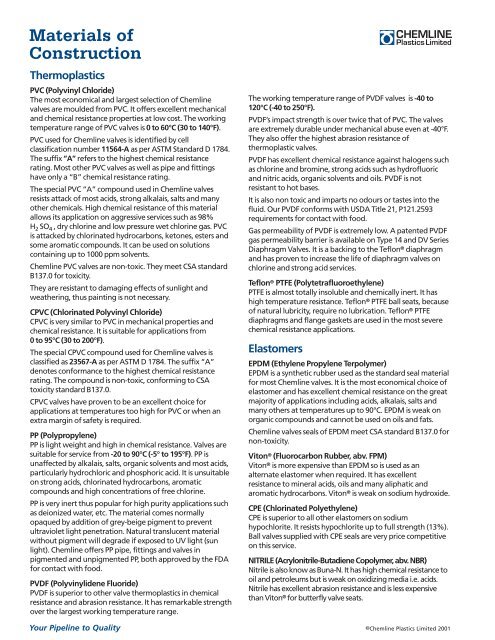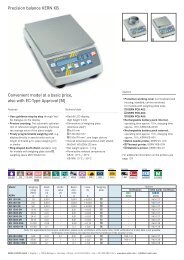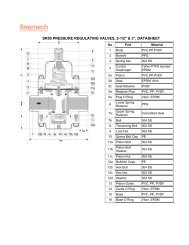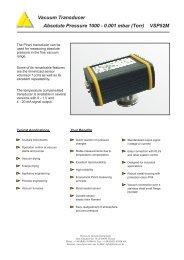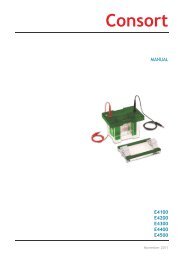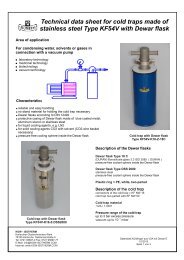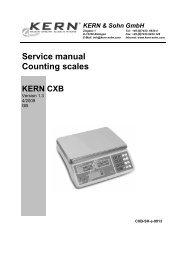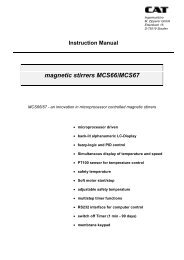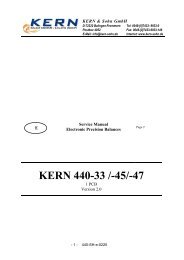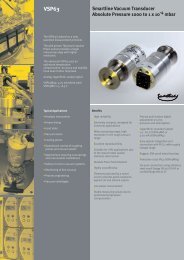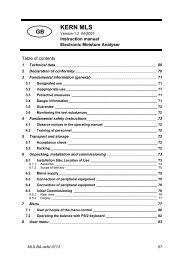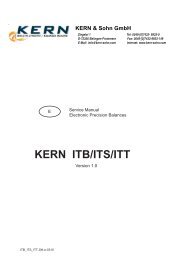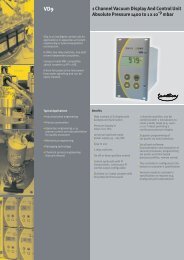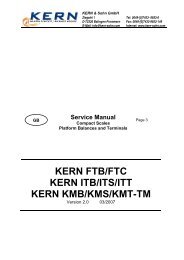Chemical Resistance Guide - FineMech
Chemical Resistance Guide - FineMech
Chemical Resistance Guide - FineMech
You also want an ePaper? Increase the reach of your titles
YUMPU automatically turns print PDFs into web optimized ePapers that Google loves.
Materials of<br />
Construction<br />
Thermoplastics<br />
PVC (Polyvinyl Chloride)<br />
The most economical and largest selection of Chemline<br />
valves are moulded from PVC. It offers excellent mechanical<br />
and chemical resistance properties at low cost. The working<br />
temperature range of PVC valves is 0 to 60°C (30 to 140°F).<br />
PVC used for Chemline valves is identified by cell<br />
classification number 11564-A as per ASTM Standard D 1784.<br />
The suffix “A” refers to the highest chemical resistance<br />
rating. Most other PVC valves as well as pipe and fittings<br />
have only a “B” chemical resistance rating.<br />
The special PVC “A” compound used in Chemline valves<br />
resists attack of most acids, strong alkalais, salts and many<br />
other chemicals. High chemical resistance of this material<br />
allows its application on aggressive services such as 98%<br />
H 2 SO 4 , dry chlorine and low pressure wet chlorine gas. PVC<br />
is attacked by chlorinated hydrocarbons, ketones, esters and<br />
some aromatic compounds. It can be used on solutions<br />
containing up to 1000 ppm solvents.<br />
Chemline PVC valves are non-toxic. They meet CSA standard<br />
B137.0 for toxicity.<br />
They are resistant to damaging effects of sunlight and<br />
weathering, thus painting is not necessary.<br />
CPVC (Chlorinated Polyvinyl Chloride)<br />
CPVC is very similar to PVC in mechanical properties and<br />
chemical resistance. It is suitable for applications from<br />
0 to 95°C (30 to 200°F).<br />
The special CPVC compound used for Chemline valves is<br />
classified as 23567-A as per ASTM D 1784. The suffix “A”<br />
denotes conformance to the highest chemical resistance<br />
rating. The compound is non-toxic, conforming to CSA<br />
toxicity standard B137.0.<br />
CPVC valves have proven to be an excellent choice for<br />
applications at temperatures too high for PVC or when an<br />
extra margin of safety is required.<br />
PP (Polypropylene)<br />
PP is light weight and high in chemical resistance. Valves are<br />
suitable for service from -20 to 90°C (-5° to 195°F). PP is<br />
unaffected by alkalais, salts, organic solvents and most acids,<br />
particularly hydrochloric and phosphoric acid. It is unsuitable<br />
on strong acids, chlorinated hydrocarbons, aromatic<br />
compounds and high concentrations of free chlorine.<br />
PP is very inert thus popular for high purity applications such<br />
as deionized water, etc. The material comes normally<br />
opaqued by addition of grey-beige pigment to prevent<br />
ultraviolet light penetration. Natural translucent material<br />
without pigment will degrade if exposed to UV light (sun<br />
light). Chemline offers PP pipe, fittings and valves in<br />
pigmented and unpigmented PP, both approved by the FDA<br />
for contact with food.<br />
PVDF (Polyvinylidene Fluoride)<br />
PVDF is superior to other valve thermoplastics in chemical<br />
resistance and abrasion resistance. It has remarkable strength<br />
over the largest working temperature range.<br />
The working temperature range of PVDF valves is -40 to<br />
120°C (-40 to 250°F).<br />
PVDF’s impact strength is over twice that of PVC. The valves<br />
are extremely durable under mechanical abuse even at -40°F.<br />
They also offer the highest abrasion resistance of<br />
thermoplastic valves.<br />
PVDF has excellent chemical resistance against halogens such<br />
as chlorine and bromine, strong acids such as hydrofluoric<br />
and nitric acids, organic solvents and oils. PVDF is not<br />
resistant to hot bases.<br />
It is also non toxic and imparts no odours or tastes into the<br />
fluid. Our PVDF conforms with USDA Title 21, P121.2593<br />
requirements for contact with food.<br />
Gas permeability of PVDF is extremely low. A patented PVDF<br />
gas permeability barrier is available on Type 14 and DV Series<br />
Diaphragm Valves. It is a backing to the Teflon ® diaphragm<br />
and has proven to increase the life of diaphragm valves on<br />
chlorine and strong acid services.<br />
Teflon ® PTFE (Polytetrafluoroethylene)<br />
PTFE is almost totally insoluble and chemically inert. It has<br />
high temperature resistance. Teflon ® PTFE ball seats, because<br />
of natural lubricity, require no lubrication. Teflon ® PTFE<br />
diaphragms and flange gaskets are used in the most severe<br />
chemical resistance applications.<br />
Elastomers<br />
EPDM (Ethylene Propylene Terpolymer)<br />
EPDM is a synthetic rubber used as the standard seal material<br />
for most Chemline valves. It is the most economical choice of<br />
elastomer and has excellent chemical resistance on the great<br />
majority of applications including acids, alkalais, salts and<br />
many others at temperatures up to 90°C. EPDM is weak on<br />
organic compounds and cannot be used on oils and fats.<br />
Chemline valves seals of EPDM meet CSA standard B137.0 for<br />
non-toxicity.<br />
Viton ® (Fluorocarbon Rubber, abv. FPM)<br />
Viton ® is more expensive than EPDM so is used as an<br />
alternate elastomer when required. It has excellent<br />
resistance to mineral acids, oils and many aliphatic and<br />
aromatic hydrocarbons. Viton ® is weak on sodium hydroxide.<br />
CPE (Chlorinated Polyethylene)<br />
CPE is superior to all other elastomers on sodium<br />
hypochlorite. It resists hypochlorite up to full strength (13%).<br />
Ball valves supplied with CPE seals are very price competitive<br />
on this service.<br />
NITRILE (Acrylonitrile-Butadiene Copolymer, abv. NBR)<br />
Nitrile is also know as Buna-N. It has high chemical resistance to<br />
oil and petroleums but is weak on oxidizing media i.e. acids.<br />
Nitrile has excellent abrasion resistance and is less expensive<br />
than Viton ® for butterfly valve seats.<br />
Your Pipeline to Quality ©Chemline Plastics Limited 2001


